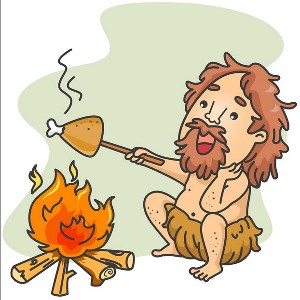 Was it the Paleo Diet that kept our prehistoric ancestors from getting fat, or was their lack of obesity due to few of them living beyond the age of forty, not having to deal with a slower metabolism, the inevitable “spare tire,” and the fast foods found in abundance today?
Was it the Paleo Diet that kept our prehistoric ancestors from getting fat, or was their lack of obesity due to few of them living beyond the age of forty, not having to deal with a slower metabolism, the inevitable “spare tire,” and the fast foods found in abundance today?
I have no opinion about the Paleo Diet, though a few people have mentioned it to me and made me curious enough to find out about it.
Apparently, the Paleo diet has been discussed (in scientific terms) since the 70’s. Then, it wasn’t discussed as a diet for people to follow today, but rather as an understanding of what foods the caveman might have survived on. The “Paleo Diet” only gained popularity as an eating lifestyle among the overweight, starting in the 90’s. I suspect that it won’t be long before some infomercial will appear on television that will make it as well known as the Atkins Diet.
The paleolithic diet (abbreviated paleo diet or paleodiet), also popularly referred to as the caveman diet, Stone Age diet and hunter-gatherer diet, is a modern nutritional plan based on the presumed ancient diet of wild plants and animals that various hominid species habitually consumed during the Paleolithic era—a period of about 2.5 million years which ended around 10,000 years ago with the development of agriculture and grain-based diets. In common usage, the term “paleolithic diet” can also refer to actual ancestral human diets, insofar as these can be reconstructed.
Centered on commonly available modern foods, the contemporary “Paleolithic diet” consists mainly of fish, grass-fed pasture raised meats, eggs, vegetables, fruit, fungi, roots, and nuts, and excludes grains, legumes, dairy products, potatoes, refined salt, refined sugar, and processed oils. Gaining in popularity due to weight loss results and improved health of those who follow the Paleo Diet, a Paleo Diet Recipe Book has been published for those who want to try eating as our stone throwing ancestors did.
Proponents of this diet argue that modern human populations subsisting on traditional diets, allegedly similar to those of Paleolithic hunter-gatherers, are largely free of diseases of affluence. They assert that multiple studies of the effect of Paleolithic diet in humans have shown improved health outcomes relative to other widely recommended diets. Supporters also point to several potentially therapeutic nutritional characteristics of pre-agriculture diets.
Since the end of the 1990s, a number of medical doctors and nutritionists have advocated a return to a so-called Paleolithic (pre-agriculture) diet. Proponents of this nutritional approach have published books and created websites to promote their dietary prescriptions. They have synthesized diets from modern foods that emulate nutritional characteristics of the ancient Paleolithic diet. Some of these allow specific foods that would have been unavailable to pre-agriculture peoples, such as some animal products (i.e. dairy), processed oils, and beverages.
The Paleo Diet does make sense. The caveman spent a huge amount of energy hunting (exercise) for wild game (leanest meats) and only ate the healthiest of wild foods they could gather (fruits and vegetables). Today, we eat genetically modified produce, hormone pumped meats, preservatives, chemicals, sugars, starches, processed oils, fat-laden foods, and a host of other packaged crap all available in abundance within a short driving distance to our home.
I may try this Paleo Diet. I’ll start by eating my neighbor’s cat – The one she lets out at night, so it can take a dump in my garden.
Disclaimer: On January 4, 2016, the owner of WestEastonPA.com began serving on the West Easton Council following an election. Postings and all content found on this website are the opinions of Matthew A. Dees and may not necessarily represent the opinion of the governing body for The Borough of West Easton.







